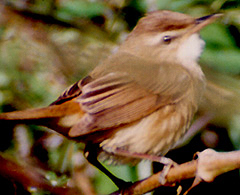Manchurian Reed Warbler Acrocephalus tangorum

One, age unknown, October 27th and 28th 2000, Gageo Island, Jeollanam Province.
Following a day of severe gale force (Beaufort Force 9) northwesterly winds, October 27th 2000 was much calmer and clearer, with strong sunlight. While checking the only wetland-type habitat in 1-Gu, Gageo Island, a series of artificial drainage ditches filled with nettles and other low vegetation, NM flushed a bright rufous acrocephalus warbler. It was small, similar in size to or even smaller than a Black-browed Reed Warbler Acrocephalus bistrigiceps, but much longer-tailed proportionately. The wings appeared relatively short, without an especially long primary projection. The bird was clearly unstreaked, overall warm-brown, with the strongest rufous-rust tones on the rump. The head pattern was much plainer than in Black-browed Reed, as although it showed a longish, off-white supercilium underlined by a relatively thin dark eye-stripe, in bright sunlight it showed only faintly darker lateral crown stripes. The face showed a different mien at different angles: occasionally "fierce", occasionally "opened-face", occasionally suggesting a darker crown or more strongly dark lateral crown stripes. The underparts were washed through with rufous, though the throat was paler, even whitish.The bill was fairly strong, up-angled, looking yellowish-pink on the lower mandible in the field with what appeared to be a clear dark tip and dark upper mandible. In photographs, however, the lower mandible appeared all pink, without any darker tip.
The bird was extraordinarily active, flitting back and forth along the ditch, feeding very actively and often calling a soft "trek-trekk" and once a louder "Chak" when accidentally flushed.
Lacking the literature or sufficient experience to confidently separate Paddyfield Warbler Acrocephalus agricola from the Far East Asian Manchurian Reed Warbler Acrocephalus tangorum (separated first by the OBC as a distinct species from A. agricola, and then by the BOU in 2002), but realising immediately that it was one or the other, NM took a series of photographs with a handheld camera through his telescope, both on the 27th and the 28th when it was last seen.
On examining the photographs Charlie Moores, who has significant experience with Paddyfield Warbler, suggested that the bird was more likely a Manchurian Reed. Subsequently, Paul Leader, a leading researcher in Hong Kong with much experience of tangorum and agricola (including many tangorum in Hong Kong and over 100 eastern agricola in Xinjiang in August 2001) reviewed the photographs on the internet and gave five reasons for its certain identification as tangorum: (1) The bill is long and deep, too deep for agricola, which always shows a finer bill than tangorum; (2) the darker crown is a feature of tangorum, and not of agricola; (3) the darker lateral crown stripes as revealed in the photographs are typical for tangorum, and at the extreme end for agricola; (4) the intensity of ginger on the rump, is typical of autumn tangorum and not agricola; and (5) agricola is considered not to show strong rufous on the lower flanks (Paul Leader in lit.).
The Manchurian Reed Warbler is believed to be largely confined as a nesting species to northeast China, wintering in Myanmar, Thailand, Laos (Robson, 2000) and probably Viet Nam (pers obs.). It has been recorded on migration through Hebei province and in Hong Kong, and nesting so close to the North Korean border, the species must be more regular on migration in Korea than this single record suggests.



